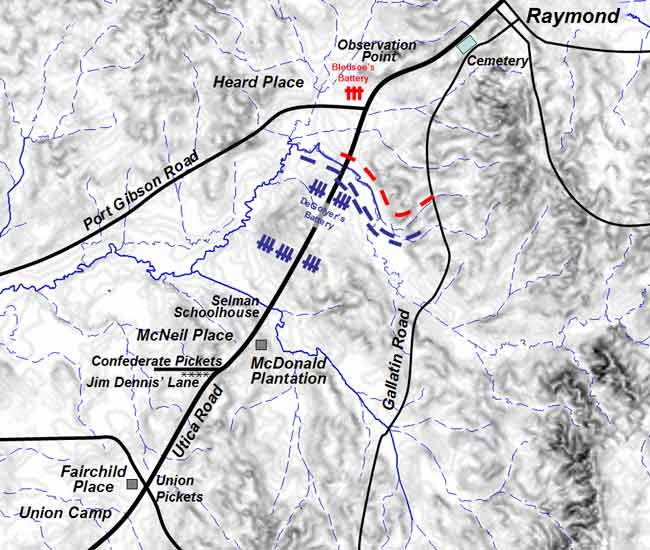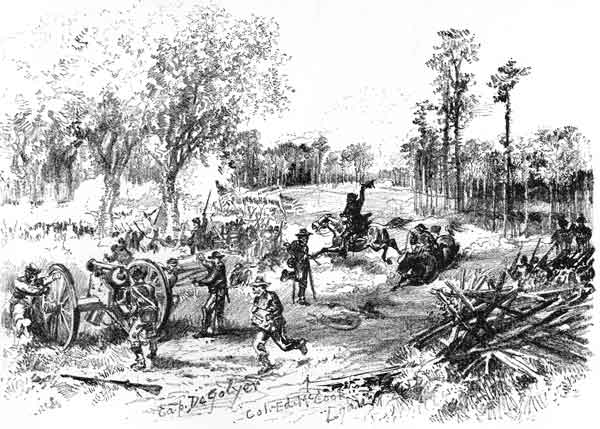|
The Battle of Raymond
by
T. B. Riggin,
Hall's Scouts Hall’s Scouts, commanded by Sgt. Robert N. Hall, was composed primarily of teenagers who were too young to join the Confederate Army. Sgt. Hall fought with the 12th Mississippi Infantry during the 1862 Battle of Seven Pines (Virginia) but returned to Raymond after losing his arm. Ladies, Gentlemen, Children, and Fellow-Citizens: We have met today, the forty-sixth anniversary of the battle of Raymond which took place the 12th day of May, 1863. While the remembrance of that is one of sadness, the occasion that brings us together should be one of pleasure. For we meet here to honor heroes; to perpetuate the memory of them, and keep alive in the hearts of the rising generations the valor and heroism of a mere handful of Confederate soldiers who stood and did battle in the face of three to one of the enemy. Now, ladies and gentlemen, I have been asked by the N. B. Forrest Chapter of the U.D.C. of Raymond to give some of my experiences in the battle that occurred here forty-six years ago. Right here I want to commend the ladies who compose that chapter, and all the other good ladies of Raymond and vicinity for their untiring zeal and energy in raising money to enclose with suitable iron fence, the graves of the soldiers who fell in battle. Now you must excuse personal mention for I speak only of my own experience. I shall begin about the 5th of May, 1863, after the battle near Grand Gulf [Port Gibson] between Gen. Bowen and Gen. Grant, which resulted in Bowen’s defeat. Our troops began to move in that direction. Referring to Military History, page 625, Lieutenant Colonel W. N. Brown moved the 20th Mississippi Regiment to Edwards. He sent a detachment of twenty men under a lieutenant to reconnoiter. They came by our place enquiring for some one to pilot them through the country toward Port Gibson, and I being acquainted with that part of our country, readily consented to go with them. After about two days the lieutenant asked me if I would carry a dispatch to Col. Brown who was then in camp at Edwards. I consented and delivered the dispatch about daylight. After reading the message Col. Brown bade me stay for breakfast, which I did and soon after left for my home. Now a seventeen year old boy had done the work of a regular soldier. This increased my patriotism, and I felt that I should go as a volunteer and help defend my country, and avenge the death of my elder brother who was killed in the battle of Shiloh. An opportunity soon presented itself to join the army. R. N. Hall of Raymond, who was discharged from the Virginia Army after losing his arm, raised a company of volunteers to serve ninety days, composed of the boys around the country and a few discharged soldiers. Being sworn in as a soldier [in the home guard and not in the Confederate Army] I felt that I must soon leave my home and mother, sisters, younger brother and my pets such as boys usually have on a farm, and all to be over run by an enemy. But bidding my homefolks goodbye, mounted on our faithful buggy horse, Dan, with my brother’s shot gun, and haversack filled with home-cooked food, I felt I was a real soldier. My first experience with the enemy came about the 9th of May at Utica when Hall’s Scouts met the advance guard of Gen. Grant’s army. [Logan and McPherson commanded the force that marched toward Raymond.] On the night of the 11th, the enemy [advancing Union cavalry] camped near the Fairchild place about five miles from Raymond. Our camp was in the woods in front of the John McNeil place four miles from Raymond. Their advance picket was at the cross road in front of the Fairchild residence; ours was at the corner of Jim Dennis’ fence at the east end of the lane [now known as the Lewis Road]. We kept watch, two at the time, two hours on duty. At two o’clock on the morning of the 12th of May, 1863, of which this is the forty-sixty anniversary, Will Osborn and I were relieved by Cal Williams and Jesse Clower. About the time we reached camp our pickets fired on the enemy who had advanced from their post. Our company of about thirty being aroused by the firing of the pickets, formed a line at the school house [Selman schoolhouse]. Skirmishing soon commenced which led to the heroic battle of Raymond.
While we could see the signal flag of the enemy they were very cautious and not until we came to the creek one mile out when they became bolder and charged us. We falling back rapidly, passed through the line of battle formed by Gen. Gregg, who fired a volley of musketry into their ranks causing them to fall back in confusion, leaving many dead and wounded on the field. Capt. Hall ordered us to charge and we followed the retreating foe as far as the bridge where I saw the first dead Yankee, who had fallen from his horse. We relived him of his rifle and saber and began to replace our shot guns with more modern guns. It was only a short while now until the Yankees advanced their skirmish line and the battle of Raymond really began.
Our company was carried out on the left flank and Capt. Hall again selected me as a special picket to watch the Raymond road, placing me on an elevated spot near the top of the sand hill a few hundred yards from this cemetery, where I had a full view of the Port Gibson road at the Heard Place, and was told to remain there until relieved unless I saw the enemy coming up the road when I was to report to him. The Batteries of Yankees were placed on the high hill near the McDonald place and opened fire on Raymond. I found myself in direct line while their batteries and the large oak tree I was under was being torn by the shells. I thought of course they were shooting at me and I moved a little down where I could see just as well; it was a good thing I did for the large oak was soon torn to pieces by the shells. This was the most trying time of my life. The battle was raging to my left, only hid from view by the small timber, the roar of musketry and the booming of the cannon, and the groans of the wounded that were being carried to the rear made me feel that none would be left to tell the tale. Knowing too that the Yankees were in possession of home and all that was dear to me, my heart felt sick; and as the noise of the battle moved further to my left toward the Palestine road, and the roar of musketry was lessening, I felt that the day was lost and that I had been forgotten. I thought of the duty of a soldier. I could not leave my post without orders; took courage by thinking of the boy that stood on the burning deck, whence all but him had fled, when to my joy I heard the familiar voice of Capt. Hall saying, "Come on Riggin, the day is lost and we will be captured unless we hurry." Our army had been outflanked by superior numbers after as fierce a conflict as took place during the war. Our army retreated towards Jackson and Hall’s Scouts followed in the rear.
This ended my experience with the battle of
Raymond but not with the war. After serving our ninety days with Capt.
Hall we were discharged to back to our homes as most of us were under
conscript age. But we had realized that even seventeen year old boys
could in some respects fill the place of full grown soldiers and instead
of going home I joined that daring band known as Harvey’s Scouts
[independent company of scouts serving as a detachment of Wirt Adams]
and served with him until discharged by a Yankee [or the end of the
war.] Harvey’s Scouts, organized in Madison, was led by Capt. Addison Harvey and comprised of 118 soldiers, many who were under age. Before organizing as a company Harvey’s Scouts, served as an independent company - primarily scouting along the Mississippi River between Vicksburg and Natchez. In 1863, the group participated in the Battle of Raymond and in 1864 played a major role the Meridian Campaign. As the war moved to the Georgia front, Capt. Harvey was assassinated by a citizen of Columbus, Georgia.
Article courtesy of Pattie Adams Snowball From the Gillespie Collection, http://raymondhistory.org Edited by James and Rebecca Drake |
||
|
| Home | Grant's March |
Gregg's March | Battle
of Raymond | Order of Battle | Commanders | Soldiers
Who Fought | Diaries & Accounts | |

